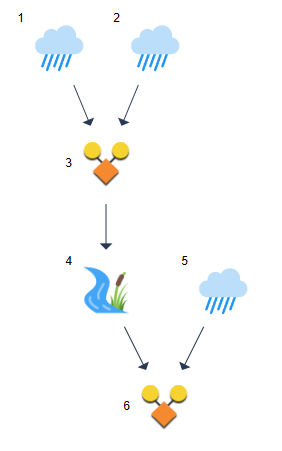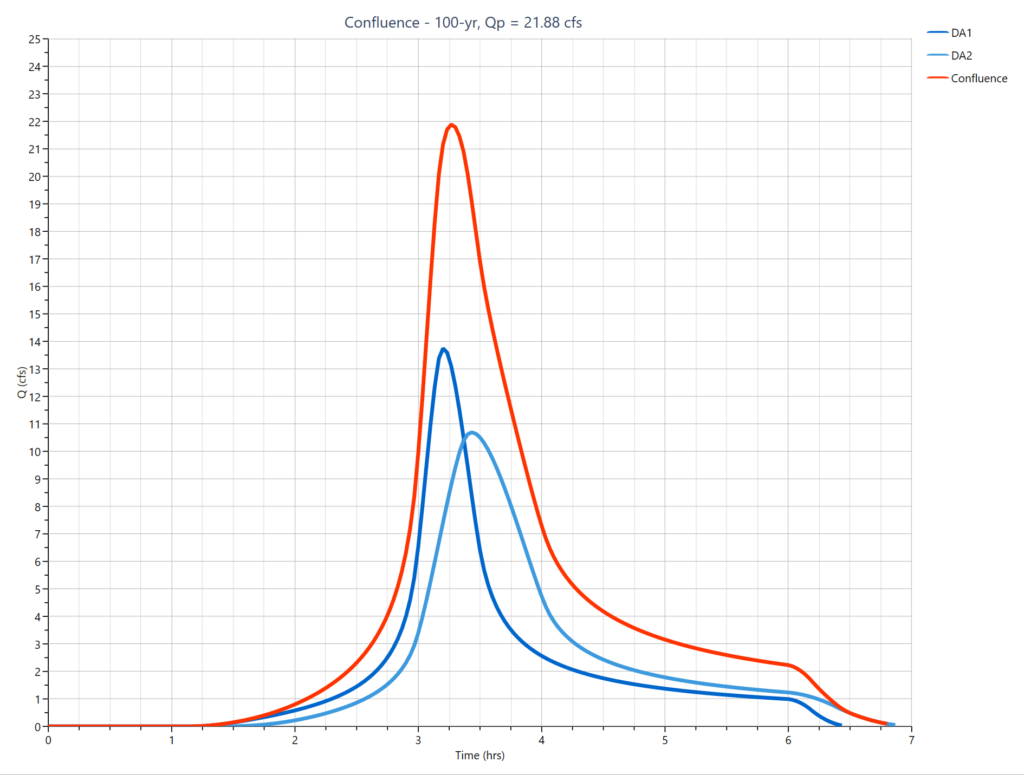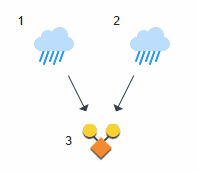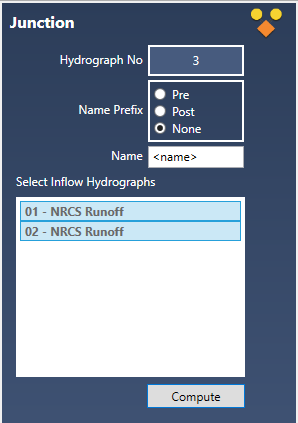When developing individual runoff hydrographs, it is assumed that the drainage areas are homogeneous, meaning they have similar CNs, slopes, and other characteristics. However, in cases where this assumption does not hold true, it is advisable to divide the watershed into distinct, homogeneous subareas. By creating individual hydrographs for each subarea and combining them at a junction, model confluence points can be established within your watershed. This article explains how to do just that.

Hydrology Studio can combine up to six previously generated hydrographs at a time. They can be of any type, for example, you can combine Runoff hydrographs with Pond Routed hydrographs. The only restriction is that you can only add hydrographs that are upstream (must have lower hydrograph numbers) of the Combined hydrograph.
It is essential to understand that hydrographs are aggregated according to time rather than flow rates. This is due to the fact that the peaks of individual inflow hydrographs can occur at varying times, influenced by their specific time of concentration (Tc), curve number (CN), area, and other factors.
The calculation method involves summing the flow rates (Qs) of the inflow hydrographs at each time interval, beginning at time zero (the beginning of the storm event) and continuing until the end of the longest hydrograph. Consequently, the peak of the final combined hydrograph may not align with the timing of the individual hydrograph peaks, and it is highly likely that the peak flow rate of the combined hydrograph will differ from the sum total of the individual hydrograph peak flows.

Combining Hydrographs
To add or combine hydrographs, select them first by dragging a rectangle around them with your mouse or alternatively, click on the icons while holding down the [Shift] key.

Then click the [Junct] button on Ribbon Toolbar.

Your model schematic will then look like this:

After the icon has been added, simply click on its icon or row, depending on which tab you are working from, to populate its input window.
Required Data
The following is a description of each of the required input items.

Name Prefix
You can include a prefix (“Pre”, “Post” or nothing to your hydrograph Name field with a single mouse click. This saves precious keystrokes when doing a pre- and post-development study and you want to identify those hydrographs that are “Pre” or “Post” development. The chosen prefix will be added to the front of the Name label on the Basin Model and throughout the software, for example, Tables, Charts, Reports, etc.
Name
Enter any descriptive name for this hydrograph. It will appear on the printed reports as well as the Basin Model.
Select Inflow Hydrographs
Select the inflow hydrographs from the list box. These are typically pre-selected based on the current Basin Model but can be edited at any time. Select or deselect by clicking on the hydrographs in the list box while holding the [Shift] key. To do the same for hydrographs that are non-adjacent, for example 2, 4, 5, 7, click while holding the [Ctrl] key.
You can only add hydrographs that are upstream (must have lower hydrograph numbers) of the Combined hydrograph.
Click [Compute] to create the junction. Below is an example as shown in the Charts tab.

The Red hydrograph is the combination of the Yellow and Green hydrographs
Combining Rational Method Hydrographs
When attempting to model a watershed using Rational method hydrographs, it is only appropriate to combine Rational method hydrographs that have the same time of concentration, Tc. Because the storm event, per the Rational method, has a duration equal to the time of concentration.
In other words, a Rational method storm begins at time zero and rains at a constant intensity, the one that corresponds to the Tc on your IDF curve, up to time Tc. Then it stops. If you attempt to combine hydrographs, each with unique Tc’s, you are then modeling multiple storm events concurrently. Each with different durations and intensity. This is not possible.
If you attempt to combine hydrographs, each with unique Tc’s, you are then modeling multiple storm events concurrently… This is not possible.
It’s okay to combine NRCS hydrographs with unique Tc’s because they are using the same design storm, for example, Type II 24-hour. Tc is simply a lagging factor, but does not change the storm’s duration.
With the Rational method, you should use only one storm event, one Tc. This Tc should be the longest of all of your hydrographs. Think of storm sewer design, where Tc is re-evaluated at each junction. Each contributing branch or tributary is compared. The longest one is used. This insures you are using the critical storm event, one that is exactly long enough to insure all areas are contributing to the peak flow, but not longer so that you reduce the intensity, underestimating the peak or a shorter time that increases intensity, overestimating the peak.



You can also simplify and use a single drainage area, composite C and only one Tc instead. Same result. Fewer hydrographs.
